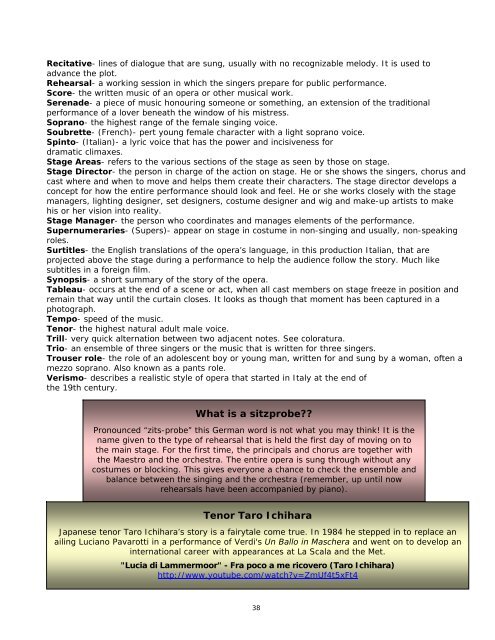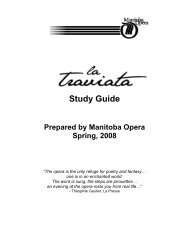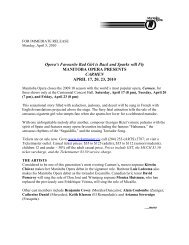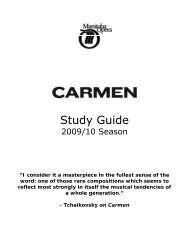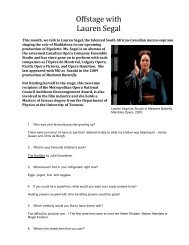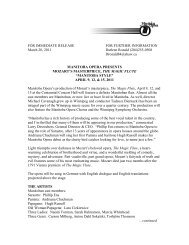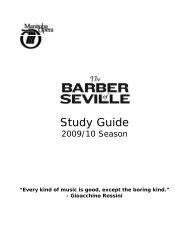The Magic Flute Study Guide - Manitoba Opera
The Magic Flute Study Guide - Manitoba Opera
The Magic Flute Study Guide - Manitoba Opera
Create successful ePaper yourself
Turn your PDF publications into a flip-book with our unique Google optimized e-Paper software.
Recitative- lines of dialogue that are sung, usually with no recognizable melody. It is used to<br />
advance the plot.<br />
Rehearsal- a working session in which the singers prepare for public performance.<br />
Score- the written music of an opera or other musical work.<br />
Serenade- a piece of music honouring someone or something, an extension of the traditional<br />
performance of a lover beneath the window of his mistress.<br />
Soprano- the highest range of the female singing voice.<br />
Soubrette- (French)- pert young female character with a light soprano voice.<br />
Spinto- (Italian)- a lyric voice that has the power and incisiveness for<br />
dramatic climaxes.<br />
Stage Areas- refers to the various sections of the stage as seen by those on stage.<br />
Stage Director- the person in charge of the action on stage. He or she shows the singers, chorus and<br />
cast where and when to move and helps them create their characters. <strong>The</strong> stage director develops a<br />
concept for how the entire performance should look and feel. He or she works closely with the stage<br />
managers, lighting designer, set designers, costume designer and wig and make-up artists to make<br />
his or her vision into reality.<br />
Stage Manager- the person who coordinates and manages elements of the performance.<br />
Supernumeraries- (Supers)- appear on stage in costume in non-singing and usually, non-speaking<br />
roles.<br />
Surtitles- the English translations of the opera’s language, in this production Italian, that are<br />
projected above the stage during a performance to help the audience follow the story. Much like<br />
subtitles in a foreign film.<br />
Synopsis- a short summary of the story of the opera.<br />
Tableau- occurs at the end of a scene or act, when all cast members on stage freeze in position and<br />
remain that way until the curtain closes. It looks as though that moment has been captured in a<br />
photograph.<br />
Tempo- speed of the music.<br />
Tenor- the highest natural adult male voice.<br />
Trill- very quick alternation between two adjacent notes. See coloratura.<br />
Trio- an ensemble of three singers or the music that is written for three singers.<br />
Trouser role- the role of an adolescent boy or young man, written for and sung by a woman, often a<br />
mezzo soprano. Also known as a pants role.<br />
Verismo- describes a realistic style of opera that started in Italy at the end of<br />
the 19th century.<br />
What is a sitzprobe??<br />
Pronounced “zits-probe” this German word is not what you may think! It is the<br />
name given to the type of rehearsal that is held the first day of moving on to<br />
the main stage. For the first time, the principals and chorus are together with<br />
the Maestro and the orchestra. <strong>The</strong> entire opera is sung through without any<br />
costumes or blocking. This gives everyone a chance to check the ensemble and<br />
balance between the singing and the orchestra (remember, up until now<br />
rehearsals have been accompanied by piano).<br />
Tenor Taro Ichihara<br />
Japanese tenor Taro Ichihara’s story is a fairytale come true. In 1984 he stepped in to replace an<br />
ailing Luciano Pavarotti in a performance of Verdi's Un Ballo in Maschera and went on to develop an<br />
international career with appearances at La Scala and the Met.<br />
"Lucia di Lammermoor" - Fra poco a me ricovero (Taro Ichihara)<br />
http://www.youtube.com/watch?v=ZmUf4t5xFt4<br />
38


